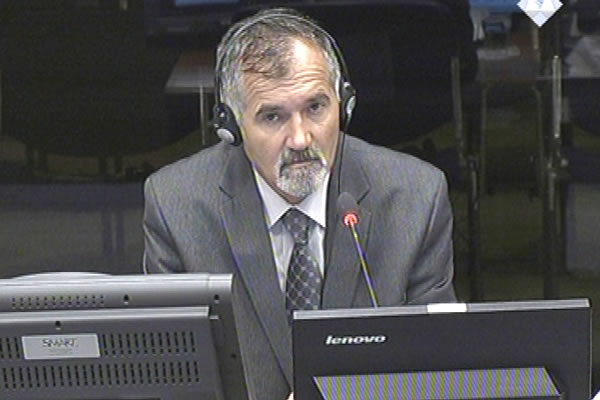Home
MLADIC’S WITNESS: ‘3,300 SERBS KILLED IN SARAJEVO’
According to defense witness Simo Tusevljak, a post-war investigation of the Republika Srpska interior ministry showed that 3,300 Serbs were killed in Sarajevo. Prosecutor Edgerton didn’t contest the fact that crimes against Serb civilians had been perpetrated but she insisted the victim list contained a number of mistakes. Some names were listed twice and Serbs killed in the artillery attacks launched by Mladic’s army on the city, such as the first Markale town market massacre on 5 February 1994, were also included on the list
 Simo Tusevljak, defence witness at Rako Mladic trial
Simo Tusevljak, defence witness at Rako Mladic trial Simo Tusevljak, former crime police officer from Sarajevo, continued his evidence in Ratko Mladic’s defense. The witness claimed that about 3,300 Serb civilians were killed in Sarajevo during the war. The figure was established by the Republika Srpska MUP investigation team; the witness was part of the team after the war. The defense tendered the victim list into evidence. During the conflict Tusevljak was the chief of the crime police in the Romanija-Birac public security center. The center was first located in Lukavica, and was later moved to Ilidza.
The witness claimed that most of the Serbs in Sarajevo were killed by snipers and shelling. Over 700 Serb civilians were killed in Grbavica alone, Tusevljak noted. Video footage of citizens stating that the attacks came from the BH Army-held territory was admitted into evidence, as was a TV report about two Serb girls who were hit by snipers. Tusevljak claimed that the shots had been fired from the direction of the Faculty of Mechanical Engineering. The defense is trying to prove that the BH Army opened fire on Serbs from civilian buildings, as this would mean those buildings were legitimate military targets and Mladic's troops had every right to attack them. In his evidence the witness also mentioned that there were 126 prison camps where Serbs were held in Sarajevo.
The prosecutor didn’t contest the claim that Serb civilians had indeed been killed in Sarajevo in various ways. In the cross-examination, prosecutor Edgerton showed conclusively that the Republika Srpska MUP list containing the names of 3,300 victims was not reliable. First, the prosecutor noted, persons killed in Olovo, Konjic, Kladanj, Rogatica, Kiseljak and other places outside the ten Sarajevo municipalities were also included on the list. Although the witness was adamant that computer software used by the Republika Srpska prevented the duplication of names, the prosecutor was able to identify 60 double entries. According to Tusevljak, the duplication was ‘potential’, not ‘real’, and the percentage of such cases was at any rate very small.
The prosecutor went on to note that as many as 1,437 entries were incomplete, with at least one key indicator missing, such as name, surname, father's name and year of birth. The witness replied that the list was not final and that it was a work in progress. The prosecutor then put it to him that the ‘non-final’ list contained the names of Serbs who were killed in the attacks by the Serb military on Sarajevo that Mladic is charged with. Jadranka Tendzera was on the victim list although she and eight Bosniak civilians were killed when a Serb shell hit Dobrinja on 4 February 1994. Marija Knezevic, Ruza Malovic and three other Serb citizens were also on the list: they died a day later when, the prosecution alleged, a Serb shell hit the Markale town market. As Tusevljak admitted, ‘it is possible’ that Serb victims killed by Serb shells were included on the list. The list was ‘open’ and corrections were always welcome, Tusevljak added.
Tusevljak said that the 3,300 victims on the list were all civilians. The prosecutor was able to show that there were also soldiers on the list, such as those who were killed in Dobrovoljacka Street in the beginning of the conflict. The witness corrected his earlier testimony, saying that the list included not only civilians but other ‘victims of war crimes’, and those could be soldiers, too. The witness will complete his evidence tomorrow.
Linked Reports
- Case : Mladic
- 2015-08-27 'I CONTEST METHODOLOGY, NOT FIGURES'
- 2015-08-25 SREBRENICA – MASSACRE OR ACCIDENT?
- 2015-08-24 DEFENSE EXPERT: PROSECUTION ‘MIXING APPLES AND ORANGES’
- 2015-09-01 SERB VICTIMS OR VICTIMS OF SERBS
- 2015-09-02 MLADIC’S TRIP FROM CRNA RIJEKA TO BELGRADE
- 2015-09-07 OFFICIAL VS. SUBJECTIVE CONCLUSIONS ON MARKALE
